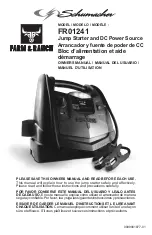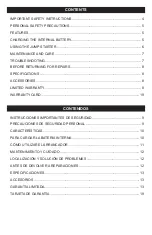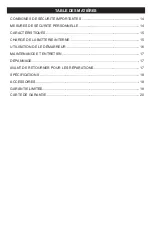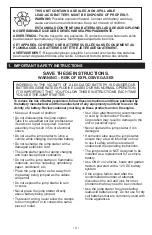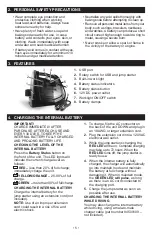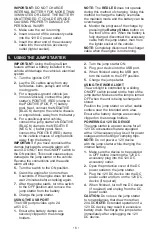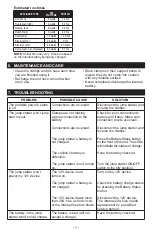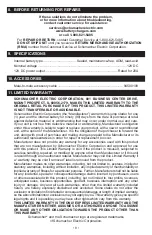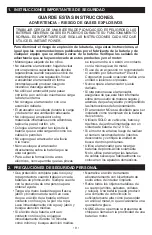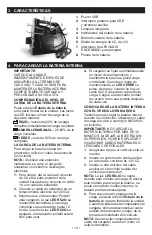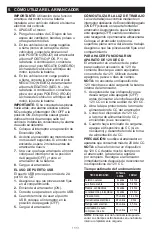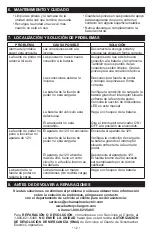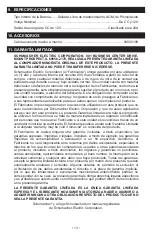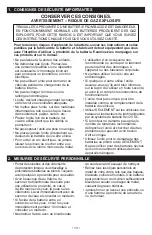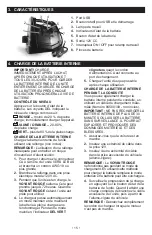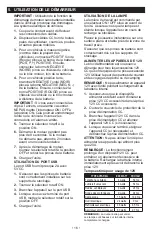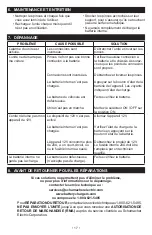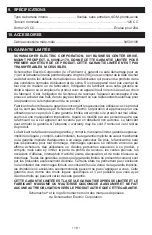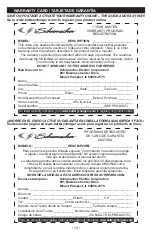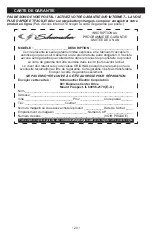
• 6 •
IMPORTANT:
DO NOT CHARGE
INTERNAL BATTERY FOR MORE THAN
30 MINUTES OR LEAVE THE BATTERY
UNATTENDED. IT COULD EXPLODE,
CAUSING PROPERTY DAMAGE OR
PERSONAL INJURY.
1.
Make sure the car is running.
2.
Insert one end of the accessory cable
into the 12V DC power outlet.
3.
Insert the other end of the accessory
cable into the vehicle’s accessory
outlet (lighter socket).
NOTE:
The
RED LED
does not operate
during this method of charging. Using this
method to charge the battery overrides
the maintain mode and the battery can be
overcharged.
4.
Monitor the progress of the charge by
pressing the
Battery Status
button on
the front of the unit. When the battery is
fully charged, disconnect the accessory
cable from the jump starter, then from
the lighter socket of the vehicle.
NOTE:
Completely disconnect the charger
cable when the engine is not running.
5. USING THE JUMP STARTER
IMPORTANT:
Using the Engine Start
feature without a battery installed in the
vehicle will damage the vehicle’s electrical
system.
1.
Turn the ignition OFF.
2.
Lay the DC cables away from any
fan blades, belts, pulleys and other
moving parts.
3.
For a negative-ground vehicle (as
in most vehicles), connect the jump
starter’s POSITIVE (RED) clamp to
the POSITIVE (POS, P, +) battery
post. Next, connect the NEGATIVE
(BLACK) clamp to the vehicle chassis
or engine block, away from the battery.
4.
For a positive-ground vehicle,
connect the jump starter’s NEGATIVE
(BLACK) clamp to the NEGATIVE
(NEG, N, -) battery post. Next,
connect the POSITIVE (RED) clamp
to the vehicle chassis or engine block
away from the battery.
IMPORTANT:
If you have connected the
clamps backwards, an audio alarm will
sound. DO NOT turn the ON/OFF switch to
the ON position. This could cause serious
damage to the jump starter or the vehicle.
Reverse the connections and the audio
alarm will stop.
5.
Turn the switch to the ON position.
6.
Crank the engine for no more than
8 seconds. If the engine does not start,
wait 2 minutes before cranking again.
7.
After the engine starts, turn the switch
to the OFF position and remove the
jump starter from the battery.
8.
Charge the jump starter.
USING THE USB PORT
The USB port provides up to 2A
at 5V DC.
1.
Ensure the battery clamps are
securely clipped on the storage
holders.
2.
Turn the jump starter ON.
3.
Plug your device into the USB port.
4.
When finished using the USB port,
turn the switch to the OFF position.
5.
Charge the jump starter.
USING THE WORK LIGHT
The work light is controlled by a sliding
ON/OFF switch located on the front of the
jump starter. Make sure the lamp is turned
OFF when the unit is being recharged or
stored.
Position the jump starter on a flat, stable
surface near the intended work area.
Ensure the battery clamps are securely
clipped on the storage holders.
POWERING A 12V DC DEVICE
The jump starter is a power source for all
12V DC accessories that are equipped
with a 12V accessory plug. Use it for power
outages and on fishing or camping trips.
NOTE:
Do not power a 12V device
with the jump starter while charging the
internal battery.
1.
Make sure the device to be powered
is OFF before inserting the 12V DC
accessory plug into the 12V DC
accessory outlet.
2.
Open the protective cover of the DC
power outlet on the jump starter.
3.
Plug the 12V DC device into the DC
power outlet and turn on the 12V DC
device (if required).
4.
When finished, turn off the DC device
(if required) and unplug from the DC
power outlet.
CAUTION:
Do not use the jump starter
to run appliances that draw more than
20A DC.
NOTE:
Extended operation of a
12V DC device may result in excessive
battery drain. Recharge the jump starter
immediately after unplugging the 12V
DC device.

